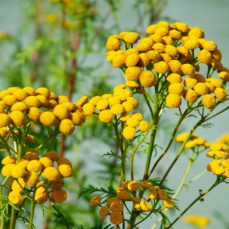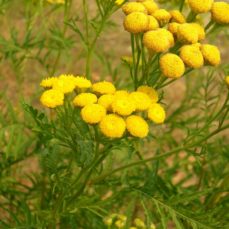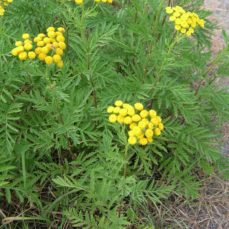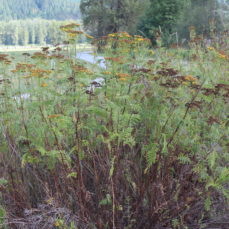
Photo credit: Dave Steers
Management Category
Squamish
Whistler
Pemberton
Vectors of Spread
ID Characteristics
General: Common tansy is a perennial forb that is a member of the Daisy family (Asteraceae).
Flowers: Common tansy flowers are button-like, yellow, aromatic and lack petals. They occur in dense, flat-topped clusters at the top of the stems. One plant can have 20 – 200 flower heads.
Stems: Are branched, purplish-red and dotted with glands. Common tansy can grow up to 1.8 m tall.
Leaves: Are deeply lobed, dark green, and finely divided and arranged alternately along the stem. Common tansy leaves are fern-like and strongly aromatic when crushed.
Seeds: Are yellow-brown with short, five-toothed crowns.
Similar Species
Invasive

Tansy ragwort (Senecio jacobea): Common tansy is sometimes mistaken for tansy ragwort because of its yellow flowers. However, common tansy flowers lack ray petals. Both species are invasive.
Habitat and Origin
Common tansy is native to Europe, Asia and Siberia. It was transported to North America for ornamental and medicinal purposes during the 17th century.
Common tansy thrives in dry areas with full sun and well-drained, fertile soils; it also grows well in wet, coastal habitats. It is often found in newly-disturbed sites, river banks, riparian habitats and pasture lands.
How it Spreads
Common tansy reproduces by seed as well as vegetatively, from roots and creeping rhizomes. Common tansy can re-grow from root fragments that have been broken off. One plant can produce up to 50,000 seeds in a season, which can remain viable in the soil for 25 years.
Common tansy is commonly spread by trade, as it is still sold by plant nurseries and herbal remedy suppliers. Its seeds are also often spread by wind, water, animals and vehicles.
Impacts
Ecological:
- Toxic to humans and livestock.
- Outcompetes and crowds out native species.
- Displaces desirable forage in pastures.
- Can restrict water flow when growing along watercourses.
Economic:
- Reduces butterfat production in cattle, causing unpleasant-tasting milk.
Prevent the Spread
Common tansy is found in the Sea to Sky region and its distribution is beyond landscape-level control. When common tansy is present at high-priority locations and negatively impacting them, their control is considered a high priority.
Otherwise, the goal is to prevent it from spreading to new (uninfested) areas, and to control it where possible to limit its impact on biodiversity.
Learn to identify common tansy: use the images presented on this profile page to learn how to identify common tansy
What to do if you spot it: You can report any common tansy sighting by visiting our reporting page.
DO:
- Regularly monitor properties for weed infestations.
- Ensure soil and gravel are uncontaminated before transport.
- Check wildflower mixes to ensure that they do not contain common tansy.
- Minimize soil disturbances (e.g., use grazing plans that prevent soil exposure from overgrazing) and use seed mixes with dense, early colonization (e.g., alfalfa or barley) to re-vegetate exposed soil and resist invasion.
- Ensure plants (particularly flowering heads or root fragments) are bagged or covered to prevent spread during transport to designated disposal sites (e.g. landfill).
DO NOT:
- Unload, park or store equipment or vehicles in infested areas; remove plant material from any equipment, vehicles or clothing used in such areas and wash equipment and vehicles at designated cleaning sites before leaving infested areas.
- Plant common tansy in a garden, no matter how well-contained its enclosure may seem.
- Move soil that has been contaminated with common tansy.
- Compost common tansy!
Control
Mechanical
Small infestations can be hand-pulled, but we recommend wearing gloves and protective clothing, as common tansy can cause skin irritation.
Mowing is not an effective control method, as the plant will respond with an increase in vegetative growth. However, mowing sites very low to the ground early in the season (before July) can prevent seed production.
Chemical
Metsulfuron methyl and aminopyralid provide effective control for common tansy. Picloram, alone or combined with 2,4-D, is also effective, but it is not suitable for wet, coastal soils.
We recommend that any herbicide application is carried out by a person holding a valid BC Pesticide Applicator Certificate. Before selecting and applying herbicides, you must review and follow herbicide labels and application rates; municipal, regional, provincial and federal laws and regulations; species-specific treatment.
Biological
No biocontrol agent is currently available in BC. However, British Columbia is part of a consortium conducting research on common tansy biocontrol.
Sea to Sky Distribution
Common Tansy Factsheet
Having trouble viewing the factsheet? Don’t worry, all the information is included on this page. You can also contact us with any questions.
Additional Resources
References
- Alberta Invasive Species Council, Common Tansy
- Government of BC, Species Account for Common Tansy
- Invasive Species Council of BC, Common Tansy
- Invasive Species Council of BC, Common Tansy TIPS Factsheet
- Invasive Species Council of Manitoba, Common Tansy
- Invasive Species Council of Manitoba, Common Tansy Factsheet
- King County, Common Tansy Identification and Control
- Nature Conservancy Canada, Common Tansy
- Wheatland County, Identification Guide for Alberta Invasive Plants
















